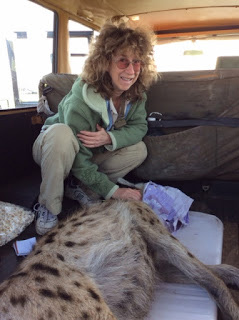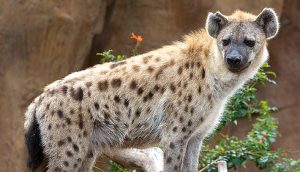The Hyena Scientist
(Scientists in the Field Series)
by Sy Montgomery and Nic Bishop
HMH Books for Young Readers, ISBN 978-0544635111
Chapter 1: A Most Misunderstood Mammal
At the den, the fluffy, spotted babies play like puppies, dashing and lunging, wrestling and spinning. Tiny infants, still coal black and lacking their spots, sit on opposite sides of a patient, older cub—each chewing gently on an ear of their tolerant sibling. Nearby, an even younger infant nurses contentedly from his mother, who’s sacked out on her side. She lifts her head, tilting her tall, expressive ears forward, and looks through the windscreen of our Land Cruiser into our faces. There is no malice in her wide, liquid brown eyes, just innocent interest. Reassured it’s just us, the mother lays her head back down and relaxes with her baby.
With long, dark muzzles, blonde coats with black spots, bristly black tails, and ears that look like a cross between a teddy bear’s and an elf’s, these animals could easily be mistaken for some exotic breed of dog. But they are only distant relatives of man’s best friend—and far more distant in human affection. Their species is almost universally despised across human cultures. Feared for biting children, hated for digging up corpses, dismissed as cowardly scavengers, the loving, social, attractive animals playing and resting before us are widely considered to be dirty, ugly, and mean.
They’re not the monsters people fear. Nor are they what they seem. Though they look like dogs, they separated from the ancestors would that lead to the dog lineage some fifty million years ago, back when Antarctica was still lined with tropical rainforests. They are actually more closely related to cats, and even more closely related to mongooses. They’re not of the mongoose tribe, either, though: they belong to their own family, the Hyenidae, a group which includes only four species: the little-known aardwolf—a small, striped, termite eater—and the striped, the brown, and the species before us, the spotted hyena.
Modern hyenas, like humans, are a recent evolutionary invention, perhaps only five million years old. Our two lineages grew up together. In fact, at least one biologist has suggested that hyenas are the reason so few fossils of early humankind exist in Africa: hyenas, whose strong jaws can crush bones and whose tough guts can digest them, ate the skeletons of our ancestors. Bad PR goes back a long time in our relationship.
“Hyenas inspire horror in people,” writes wildlife biologist Hans Kruk. “Hyenas are inexorably linked with garbage cans, corpses, feces, bad smells and hideous cackles.”
In The Green Hills of Africa, Ernest Hemingway called the hyena a “devourer of the dead, trailer of calving cows, ham-stringer, potential biter-off of your face at night while you slept, sad yowler, camp-follower, stinking, foul, with jaws that crack the bones the lion leaves, belly dragging, loping away on the brown plain….”
A century before he penned those words, Samuel Griswold Goodrich noted in his Illustrated Natural History of the Animal Kingdom that, while even villains like Aaron Burr and Judas Iscariot had their defenders, it seemed no one would say a kind word about hyenas. Even Disney’s movie The Lion King managed to portray hyenas as conniving, cowardly thieves.

Just yards from our vehicle, the fuzzy cubs scamper ‘round the den, bucking and twirling, as the vanilla light of an African afternoon haloes the plush fur on their ears. “How can you not like hyenas when you see this?” asks Kay Holekamp, 62, a zoologist from Michigan State University. “They’re adorable!” Kay’s behind the wheel of our Land Cruiser here at southwest Kenya’s Masai Mara, one of the most spectacular wildlife reserves in Africa, and she knows each of these cubs by name—as well as their mothers, fathers, grandmothers, and in many cases, great-grandmothers.
Kay’s research on the spotted hyena is one of the longest continuously-running field studies of any mammal in the world. Kay has been at it for three decades—and her findings are clearing up the animal’s bad rep, revealing the spotted hyena as an unexpectedly brave, smart, and extremely social species.
Instead of a skulking scavenger, the spotted hyena is a skilled and mighty hunter—the second biggest, and the most formidable, carnivore in Africa. Though all hyenas evolved from scavenging ancestors, and they will happily devour any food they can find, Kay has found that spotted hyenas (unlike the striped and brown) directly kill sixty to ninety five percent of the food they eat. A single, 130-pound female is capable of running down and killing, unaided, a bull wildebeest three times her own weight—and can scarf the carcass down in half an hour. Spotted hyenas are keystone predators who control the health of the ecosystem. “Take hyenas out of the picture and all kind of things would go out of control,” says Kay. That once happened in South Africa, when farmers decimated hyenas and their fellow predators. The result? Ecological disaster: explosions of herbivores reduced grasslands to deserts. Soil erosion ruined roads and altered the course of rivers.
Kay has pioneered a new way of looking at hyenas, showing them in an entirely new light. “Hyenas are often pictured slinking around, hassling the ‘real’ predators—waiting to steal food from a lion,” Kay notes. “But very often, it’s the other way around.” As it turns out, lions steal food from hyenas more often than hyenas steal from lions.
Instead of a filthy, smelly brute, the spotted hyena is a creature who spends a considerable amount of time and effort on grooming. “Sure, they have bad hair days,” admits Kay—hyenas sometimes lie in mud to cool off in the African heat. “But then they groom themselves and become spiffy clean.” Because their tongues are rough like cats’, hyenas can use them like fine-toothed combs on their fur. They groom both themselves and each other. Fur fur-free areas get a good licking, too. Mothers are particularly attentive to their babies’ hygiene, even cleaning under tails when necessary.
Even the hyena’s fabled laugh isn’t what people think. There’s nothing funny about it to a hyena. Instead of an hysterical giggle, it’s actually a sound of frustration, uttered, for instance, when someone—like a lion—steals their food. And the giggle is just one of the astounding sounds in the hyena’s extensive vocabulary: They rumble (typically a sign of worry). They groan (usually a mother calling her cub.) They low like contented cattle—when hyenas are preparing for a coordinated behavior, like mobbing a rival group. Their impressively rich repertoire ranges from the elastic “whoop”s that echo through the African night—sometimes to announce the presence of a kill, sometimes to gather fellow hyenas for a group activity, and sometimes a complete mystery–to the cubs’ high-pitched “eeeeee!” known as squittering, which babies use to demand “More milk!” from their moms.
In a way, it’s no wonder that people get hyenas so wrong. “Hyenas are like no other animal,” Kay says. “They’re the coolest animals out there, because they are just really weird.”
For starters: hyena females look like males. In most mammals, the males are bigger than the females. With hyenas, not so—the females are ten percent bigger. And if you check underneath, both males and females look alike. It’s so confusing that years ago, when a collector was sent to capture hyenas for a zoo, he reported he could find only males….until, that is, one of his captured “males” gave birth in front of his eyes—though a tube-like organ that looked exactly like male equipment. (“It’s like giving birth through a soda straw!” comments one of Kay’s assistants.) For years, people believed hyenas were hermaphrodites—each with both male and female sex organs. Today scientists know that’s not true, but they’re still awed—and perplexed—by the evolutionary forces that sculpted such a bizarre female reproductive tract.
Among hyenas, sex roles are reversed. Females are far more aggressive. Ladies rule in hyena society—a very rare situation among mammals. And hyena society is unusually rich and complex, comprised of clans which can number more than 100 individuals. All members of the clan know each other, and each has an assigned rank, inherited from birth, which everyone in the clan knows and respects. Though each individual hyena may spend much time alone or in small groups, clan members cooperate to raise cubs in communal dens. They defend a common territory from rival clans. In this way, hyena society is sort of like a feudal kingdom—except the kings are queens.
“Hyenas appear to violate the rules of mammalian biology,” says Kay. That’s what makes them so fascinating and important to study. “Studying the oddballs can teach you about the basics,” Kay explains. “They allow us to gain insight into what the rules actually are.

“Spotted hyenas can teach us a tremendous amount about a lot of different things,” Kay insists. Over her many years of study, she has hosted more than 100 grad students and research assistants, each pursuing some different aspect of hyenas’ mysteries. How did their social networks and intelligence evolve? How do sex hormones affect aggression and dominance? What do hyena vocalizations mean? What roles do postures, gestures, and scent marking play in communication?
The questions go on and on. And solving mysteries about hyenas may have unexpected applications. For instance, notes Kay, “Their immune systems are amazing; they can eat anthrax and survive. Wouldn’t it be great if hyenas could give us a way to help people recover from food poisoning?”
Then, there’s their teeth: hyenas’ are the only ones in the animal kingdom strong enough to crack the massive leg bones of a giraffe. “Car companies want a synthetic paint as strong as the enamel on hyena’s teeth!” Kay says. “And…”
She could continue, but a newcomer arrives at the den. She’s a radio collared female, and Kay doesn’t even have to swing her binoculars up to her eyes to identify who this is: “It’s BUAR!” she announces—which is the four-letter code for her real name, Buenos Aires. She’s the highest ranking female, the leader of the group, the undisputed queen of the clan. “Hi, BUAR!” Kay greets the seven-year-old matriarch like an old friend.
Which she is. Kay has followed BUAR’s life ever since she was born in December of 2009. She has measured every part of her body, examined her blood and feces, tracked her movements, followed her children. After BUAR’s mother, Murphy, was killed by a lion in April, 2011, Kay and her students chronicled BUAR’s rise to the throne, to the top of the hyena hierarchy.
To meet BUAR and the clan she rules, photographer Nic Bishop and I have come to Kay’s camp here in Masai Mara. We’ll accompany Kay and her research team as they study the Talek West Clan—one of four hyena clans in the area. BUAR’s is the mightiest of the empires. Talek West is the largest hyena clan ever recorded, with 130 animals—three times larger than most estimates of average clan size elsewhere.
Last summer, Kay tells us, her research team began seeing evidence of a possible split in the clan. If such an event is really happening, it will pit sisters against sisters, mothers against daughters—a drama worthy of Shakespearian tragedies or Hollywood action films. We’re hoping to catch a glimpse into hyena society at what might be a critical turning point in Talek West Clan’s history. It’s a rare opportunity to add a fascinating piece to the puzzle of understanding hyenas’ rich and complex social system.
Nic and I could watch the babies play at the den forever, but it’s time to check on what other members of the can are doing. “Let’s back off,” says Kay, “and see what else we can find.”

